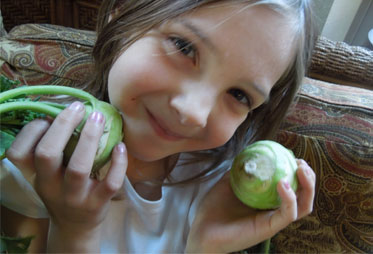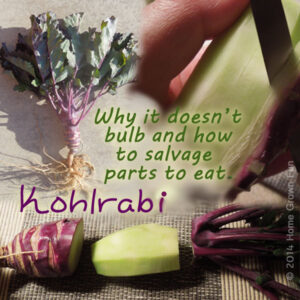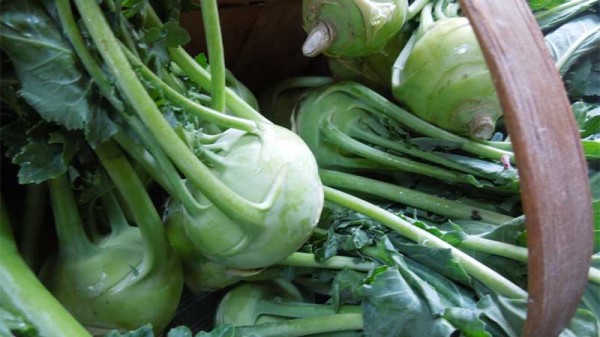TIPS FOR GROWING GREAT KOHLRABI
 WHAT IS THE TASTE AND TEXTURE OF KOHLRABI?
WHAT IS THE TASTE AND TEXTURE OF KOHLRABI?
Kohlrabi tastes like a combination of a turnip, radish and cucumber – on the mild side. The alien-looking bulb grows above the soil. You peel it and it is most tender toward the top.
The leaves are also edible and make great chips. We bake them at home and in the solar oven at school. There are several varieties that come in white, green and purple.
There are hybrid varieties.
We grow open-pollinated and heirloom kohlrabi: Early Purple Vienna and Early White Vienna. We have grown a huge kohlrabi that does not get tough when large and its name is Superschmeltz!
WHEN TO PLANT KOHLRABI?
In Southern California and other warmer climates, kohlrabi grows well during the cooler months from October to February. It grows quickly and can stand some frost. Lucky gardeners in zones 9-10 can sow seed successively during the fall and winter for multiple harvests until early spring. In cooler climates, sow seed in the fall making sure to get seed in the ground 8 to 10 weeks before the first frost.
Spring sowing works well too. Sow seed in spring 4 to 6 weeks before the last frost. You can also start them inside 6-8 weeks before the last frost, then transplant outdoors when they reach about 4 inches tall.
LOCATION, SOIL AND COMPOST FOR KOHLRABI?
Plant kohlrabi in full sun and in soil that drains well. Brand new seedlings though may benefit from some shade if the weather is hot. I would not grow kohlrabi in a spot where anything from the cabbage family grew before.
It’s best to rotate your crops to reduce the chance of disease, pests and soil nutrient deficiency. Kohlrabi grows best in soil that is loose and amended with compost.
A good rule of  thumb is to lay 2-3 inches of compost on a garden bed and work it into the first 6 inches of soil.
thumb is to lay 2-3 inches of compost on a garden bed and work it into the first 6 inches of soil.
Did you know that compost can regulate your pH levels to a great range for kohlrabi, eliminating the need to do soil testing and modification? Amend with compost before you plant instead of side dressing later.
HOW TO PLANT KOHLRABI SEEDS?
Plant the seeds in the ground ¼-½ inch deep and space them at least 6-8 inches apart. If you overcrowd the plants some may not create bulbs not only because the plants are competing for nutrients but because light will be blocked by neighboring plants and delay the formation of the bulbs.
When bulbs are delayed, the texture of the vegetable will become woody. It should take a few weeks to get strong seedlings. You can plant them closer to start and then thin later. If that is your plan, space them 3 inches apart.
HOW TO THIN KOHLRABI SEEDLINGS?
If you planted too close together and need to thin your seedlings, do not compost the extra plants!
ALERT – GOOD NEWS! All other articles on the internet say to compost the extra seedlings. NO! If you have the space, carefully replant them elsewhere in the garden. They will grow fine.
I have done this many times  with almost 100% success. I discovered this a few years ago when I yanked many extra seedlings out of the ground and as an after-thought, stuck them back in the raised bed as an experiment.
with almost 100% success. I discovered this a few years ago when I yanked many extra seedlings out of the ground and as an after-thought, stuck them back in the raised bed as an experiment.
HOW TO WATER AND MULCH KOHLRABI?
Keep plants consistently well-watered and free of weeds. If the garden bed goes too long without water it will stress your plants and they may not bulb.
Make sure your soil drains well. Soggy roots will damage kohlrabi.
Put down a mulch to keep moisture in. Spent beer grains (learn more in my eBook), dried grass or straw make a good mulch for kohlrabi. Kohlrabi roots grow near the surface so be careful applying mulches and soil amendments.
BEST FERTILIZERS FOR KOHLRABI?
Kohlrabi benefits from soil amendments such as compost and worm castings because they contain a variety of nutrients. Nitrogen is important very early on but not toward the middle or end of growth.
Sometimes when there is a delay in growth we think to fertilize with nitrogen, but too much nitrogen will cause tops to grow vigorously at the expense of the edible parts. Your bulbs may crack too if nitrogen is applied too late.
The best time to apply nitrogen-based fertilizers is after seedlings reach 4 inches tall, about a month after sowing seed. I like using homemade fish fertilizer because many commercial fish emulsions contain heavy metals and are not suited for organic farming.
Alfalfa horse feed in pellet form also works great. Worm castings applied every two weeks add micronutrients and I am a firm believer that worm tea wards off pests.
There are many homemade fertilizers you can make yourself with materials found around the house or nearby for FREE. I put together 50 recipes using over 30 natural and organic ingredients: 50 Homemade Fertilizers and Soil Amendments. You can preview the book and see the table of contents on this page.
Common Pest of Kohlrabi?
Pick and discard of snails regularly. Keep them out of your bed with organic pellets, upside down boards with crushed snails for bait, beer traps or copper shields. Make sure to bury a portion of the copper strips to keep snails from burrowing under the barrier.
Cabbage loopers and cabbage worms can also be a problem. If I think I need to cover my beds to prevent cabbage moths from laying eggs, I apply a floating row cover using material made for that purpose or a thin piece of cloth that will let lots of light in.
Wedding tulle fabric works great! It’s now my go-to, inexpensive and easily accessible row cover! I won’t grow kohlrabi, kale, broccoli, or other cole crops without it!
WHEN AND HOW TO HARVEST KOHLRABI?
The key to great tasting kohlrabi is to pick them at their prime, not when they’ve become overgrown. Kohlrabi takes about 6-7 weeks to reach maturity. Mine seem to be ready in about 55 days.
The purple  type takes a week longer. The size of a tennis ball is ideal and no more than 2 inches in diameter.
type takes a week longer. The size of a tennis ball is ideal and no more than 2 inches in diameter.
If the weather where you live is very cold, you might be able to wait a bit until they are a little larger. Bring along a tool to cut above the roots so that you won’t make a mess pulling up big clumps of garden soil.
Keep the leaves attached because you can use those to make chips.
HOW TO STORE KOHLRABI?
Keep bulbs and leaves in the refrigerator. They should keep for a few weeks at least. If you want to make chips from the leaves and would like the process to be convenient as possible, remove the leaves and take away all middle stems.
Keep the leaves in large pieces, 2-4 inches across and store in a container in the refrigerator for easy access.
HOW TO EAT KOHLRABI?
Kohlrabi tastes great raw or sauteed in a little olive oil. Young leaves taste great in stir fries. Roast them (see recipe below) as a snack on a whim or right before a meal for that satisfying crunch factor.
HOW TO SOLVE COMMON PROBLEMS WITH GROWING KOHLRABI?
WHY WON’T MY KOHLRABI MAKE BULBS?
Crowding will block light and delay bulbs. Space your plants at least 6″ apart – 8″ might be better. Over and under watering, and too many weeds can also stress it.
The best tasting kohlrabi bulbs out rapidly. I transplanted several plants to another location (as I thinned) and they grew beautifully. Pick when smaller than a tennis ball.
WHY IS MY KOHLRABI CRACKING?
Bulbs that split or crack are usually a result of too much nitrogen fertilizer too late in the growth cycle. Another possibility is drought.
CAN I EAT KOHLRABI THAT DOESN’T FORM A BULB?
Yes. If you act fast. Don’t let it get too old. If your kohlrabi doesn’t bulb out, don’t compost it without first salvaging part of it. The section closest to the root will be inedible, very woody. So you’ll want to cut that off until you reach a more tender area.
The part closest to the stems will be the softest. Try to keep as much kohlrabi near the stems as possible. Peel off a little more of the skin than usual. Eat it raw (I pack it in kids’ lunches) or saute in a little olive oil and a pinch of sea salt.
HOW DO I MAKE KOHLRABI CHIPS?
Use the leaves to make roasted chips, just like kale. I make mine by removing all stem parts and sectioning the leaves into good sized pieces. LIGHTLY coat the leaves in olive oil and place them on parchment on a baking sheet so they don’t overlap.
Sprinkle with sea salt (be careful not to over-season) and bake in a preheated oven for 10-15 minutes at 375°F. Watch closely and take out before the chips turn brown. The best time to remove the chips is at the point when they become stiff (earlier than you might think – test one with your finger to see if it is rigid).
We also bake these in our school solar oven – just takes longer since we only get up to about 180°F.
For more ideas on how to eat kohlrabi, please visit this awesome post here on the site. I wrote it with passion because we just love KOHLRABI!



